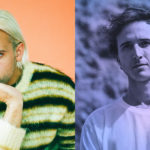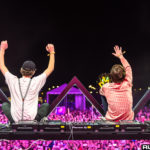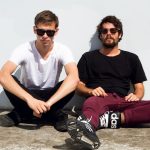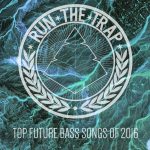 As muffled bass resonates through Republic’s green room, Chris Emerson aka What So Not is all smiles before his headlining set in New Orleans, Louisiana. Rocking a swaggy OWSLA jacket and an Aussie accent, the Sydney-based producer emits an infectious aura of energy that is perhaps not so surprising if you’re familiar with his music.
As muffled bass resonates through Republic’s green room, Chris Emerson aka What So Not is all smiles before his headlining set in New Orleans, Louisiana. Rocking a swaggy OWSLA jacket and an Aussie accent, the Sydney-based producer emits an infectious aura of energy that is perhaps not so surprising if you’re familiar with his music.
Since parting ways with former bandmate Flume last February Chris has taken the WSN project to new heights, touring just about everywhere around the world in preparation for his highly-anticipated Gemini EP. With collaborations alongside Skrillex, ASAP Ferg, Dillon Francis, Dawn Golden and more, the future is bright for one of dance music’s biggest stars. We sat down with the iconic producer himself to talk Gemini, touring, and the world of What So Not in this exclusive Run the Trap interview.
RTT: Gemini is easily one of the most highly-anticipated releases of the year. What exactly does this EP and the WSN project in general mean to you?
What So Not: This project has been my life for a long time. It’s been unreal, especially in the last couple of years really delving heavily into the creative side of things and working with some amazing artists from producers to rappers and vocalists. Seeing what inspires people from different cultures and different backgrounds, as well as being influenced by them is an amazing experience. That’s the beauty of traveling around the world DJing is that you get yourself into situations you would never be in otherwise. You suddenly find yourself in a country or region that inspires you, whether it’s from the environment or the people. It develops you as an artist in a lot of ways.
You’ve mentioned that this EP is “more mature” creatively than previous What So Not productions. How so?
Harley (Flume) and I had spent a lot of time apart working on our own projects, so when we came back together to produce Gemini it was definitely a different feel and a different sound; it was more mature. We both developed in different ways over time and we sort of brought that together and it just sounded different. I think it sounds a lot cooler than our previous stuff and hopefully people think so as well.
What’s the ideal listening environment you would want your Gemini EP to be listened in?
Well the idea is that you can listen to it anywhere. We didn’t want to make it so abrasive and hard that you couldn’t listen to it quietly in your bedroom and we didn’t want it so soft where you couldn’t play it at a festival. We wanted people to be able to listen to it anywhere. While that’s not the easiest way to approach writing songs and it was a fun challenge and I think it worked out well.
You’ve talked a lot about the importance of ‘creating a world’ for your music to live in. Tell me about the WSN world.
I’ve been working with designers, fashion stylists, all types of people for a while now trying to create this visual world. We went back and forth on concepts, unreleased material, current material that’s out, and slowly started to develop this WSN imagery that’s reflected in the music. All of these amazing artists really pushed me creatively and it was a great learning experience working with them. Now, it’s exciting when I have the opportunity to have a Vjay on the road with me because it makes my live show more into a narrative experience rather than just a DJ set. This is the first time I’ve dealt with this element where there’s multiple senses being appealed to so it’s really exciting.
How is this visual element important to you as an artist?
Every song, you see something when you hear it. With music in general you can just sit down and close your eyes and always imagine something. Maybe a lyric or a specific sound resonates and takes you somewhere, but that visual element is always there in some form. I guess it’s just all about that.
Describe your sound without using the names of any genres.
I’m always trying to make my music epic. Epic, but warm. I try to have an atmospheric feel to it as well so it’s not stale and doesn’t feel too synthetic. I guess ultimately I’m trying to create a mood, but not always the same mood. I’m always trying to produce something that instantly resonates and has a vibe that people can connect with.
When I listen to WSN I hear this duality between lush melodic soundscapes and huge sounding club-oriented synths and instruments. How do you find a cohesive balance between the those two very different vibes?
It’s hard man, but I found this really good way of writing songs where you break it down into sections. You have an ‘A section’ which has strong chords that grow and develop. You start stacking and building harmonies, adding vocal chops, effects, and strong percussive elements that build up the tension. Then there’s the ‘B section’ which is the heavy drop with strong kicks and subs that wobble around a bit. You can put some weird glitchy sounds with melodic chord stabs here and there to give it some vibes. Then you have the third section which is similar to the epic beautiful section in the beginning but you put the percussion of the drop underneath it, so you push the A and B sections together. It makes the song round out. Then you flesh it out, add harmonics and start shifting the chords around to make the track feel like it’s moving.
What should someone expect from a typical WSN set?
I just try to make my sets really fun. I’ll spend a bit of time at the venue beforehand as well just to get a feel for it all. I always try to come in early and listen to what the DJ before me is playing. In terms of song selection I play tracks that I love, my own production, edits, bootlegs, and unreleased originals. The challenge is trying to fit them all together in a cohesive way.
You’ve had a pretty busy touring schedule this year. How do crowds from around the world react differently to your sets?
There’s not much difference to how they react to the WSN songs, it’s really the stuff in between. In Australia I’ll play some Ferg tracks and they won’t know them as well but then I’ll go to Brooklyn and people go crazy! The same goes with Europe, I was really surprised when I went there for the first time because I thought I had to play more house and techno kind of stuff. I did, but I think they’re just so used to those genres that they’re not phased by it. But then I played some weird Carmack or Losco shit and they went nuts. Europe has this thirst for the stranger kind of experimental gritty sound. It wasn’t what I was expected and it was really interesting.
Australian artists, you in particular, are largely credited for this huge future bass boom on the scene. Where do you see this genre going in the future?
There’s a lot of people doing it now, and a lot of people doing it really well. So there’s definitely gonna have to be something different involved very soon, something new, something taking what’s happened with it all so far and pushing it somewhere else.
How do you feel about the growing copyright issues facing soundcloud and it’s destructive effects on modern day remix culture?
Yeah that sucks because I credit soundcloud and hype machine and outlets like that for the success of this What So Not project. It’s such an easy way for young kids working at home to showcase themselves and get noticed. I don’t really have songs on the radio. I do on triple J on Australia and maybe some college radio stations over here but really it’s all on the internet. I couldn’t be where I am today without soundcloud so it disappointing all of this is happening now. Maybe it’ll push people to other realms or to create more original music from scratch. But it’s hard when you’re first starting out because you don’t have access to vocalists all the time so what do you do? You get an acapella, you get something from the 90’s and it helps get you exposure tremendously. That was my way of showcasing my music so again it’s too bad soundcloud is going through all that right now.
Collaboration has always been an integral part of WSN. What is it about Collaboration that’s so important to you as a musician?
Even now with What So Not just being me I still see it as a collaborative project. I just love working with other people. I feel like you can always do something better when it’s a team effort. I’ll write a piano melody, but then I’ll find someone who’s actually a pianist to come in and play it live to give it that feel and energy. They’ve had 15 years of experience doing that so obviously they’ll do a better job than me. I can write chords, I can write melodies but I can’t physically play it like they do. Collaboration is really about what you can learn and take from other artists.
Best advice for upcoming producers?
Definitely work hard. You gotta work hard in the right ways. For example I stopped using effect plugins for about a year aside from ableton presets, just training myself on what everything actually did. I wanted to do everything from scratch, from the basics, so that when I used those more enhanced plugins I could control them better and know exactly how to make a certain sound. People hear all these crazy sounds in their heads and it’s hard to get them out quickly enough before the idea goes away. So with doing things like that you build up a skill set so you can write those fleeting ideas down as fast as possible. There’s a process you should go through of really training yourself, getting in there and working on different technical aspects of production. It really pays off in the grand scheme of things.
What would you be doing if you weren’t DJing / producing?
Probably really sad. I’d probably have a life that was boring and I didn’t even know it was boring. And i’d be really complacent (laughs).
Any last words for What so Not / Run the Trap fans?
Thank you Run the trap for always supporting. Honestly you guys are on it so early. Thank you to all the fans for being patient with Gemini and for coming to the shows. These past few months have been amazing and I’m really excited with moving forward and everything that’s to come in the future.
–
Follow What So Not
Soundcloud | Twitter | Facebook








WSN is certainly of form catharsis.